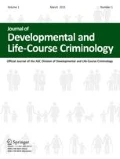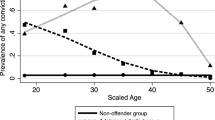Abstract
Purpose
The main aim of this article is to investigate the duration of criminal careers, to assess how many offenders desist from offending (i.e., terminate offending) up to age 61.
Methods
The Cambridge Study in Delinquent Development is a prospective longitudinal survey of 411 London males originally studied at age 8 in 1961. Their criminal records have been searched repeatedly up to age 61, and their self-reported offending was measured up to age 48, when 93% of males were interviewed.
Results
Forty-four percent of males were convicted, and many criminal careers were very long; 26% of convicted males had a duration of 20 years or more. The probability of being reconvicted was substantial even after a gap of 10 (20%) or 15 years (19%) after the previous conviction, but it was only 8% after a 30-year gap and only 6% after a 40-year gap. Offenders who had been conviction-free for 30 or more years since their last conviction had a similar self-reported offending score to non-offenders at age 48.
Conclusions
It seems likely that those offenders (49%) who had been conviction-free for 30 or more years had truly desisted. In contrast, those offenders who were conviction-free for less than 10 years (22%) probably had not desisted up to age 61. Desistance is more uncertain for the remainder of the offenders.
Similar content being viewed by others
References
Blumstein, A., Cohen, J., Roth, J. A., & Visher, C. A. (Eds.). (1986). Criminal careers and “career criminals” (Vol. 1). Washington, DC: National Academy Press.
Piquero, A. R., Farrington, D. P., & Blumstein, A. (2003). The criminal career paradigm. In M. Tonry (Ed.), Crime and justice (Vol. 30, pp. 359–506). Chicago: University of Chicago Press.
Piquero, A. R., Farrington, D. P., & Blumstein, A. (2007). Key issues in criminal career research: new analyses of the Cambridge Study in Delinquent Development. Cambridge, UK: Cambridge University Press.
Bushway, S. D., Piquero, A. R., Broidy, C. M., Cauffman, E., & Mazerolle, P. (2001). An empirical framework for studying desistance as a process. Criminology, 39, 491–515.
Jennings, W. G., & Fox, B. H. (2019). Acceleration, deceleration, escalation, and de-escalation. In D. P. Farrington, L. Kazemian, & A. R. Piquero (Eds.), The Oxford handbook of developmental and life-course criminology (pp. 70–80). New York: Oxford University Press.
Whitten, T., McGee, T. R., Homel, R., Farrington, D. P., & Ttofi, M. M. (2017). Disentangling operationalizations of persistent offending. Journal of Criminal Justice, 52, 22–33.
Jolliffe, D., Farrington, D. P., Piquero, A. R., MacLeod, J. F., & Van de Weijer, S. (2017). Prevalence of life-course-persistent, adolescence-limited and late-onset offenders: a systematic review of prospective longitudinal studies. Aggression and Violent Behavior, 33, 4–14.
Blumstein, A., Cohen, J., & Hsieh, P. (1982). The duration of adult criminal careers: final report to National Institute of Justice. Pittsburgh, PA: Carnegie-Mellon University.
Piquero, A. R., Brame, R., & Lynam, D. (2004). Studying criminal career length through early adulthood among serious offenders. Crime and Delinquency, 50, 412–435.
Farrington, D. P. (1992). Criminal career research in the United Kingdom. British Journal of Criminology, 32, 521–536.
Farrington, D. P., Lambert, S., & West, D. J. (1998). Criminal careers of two generations of family members in the Cambridge Study in Delinquent Development. Studies on Crime and Crime Prevention, 7, 85–106.
Farrington, D. P., Coid, J. W., Harnett, L., Jolliffe, D., Soteriou, N., Turner, R., & West, D. J. (2006). Criminal careers up to age 50 and life success up to age 48: new findings from the Cambridge Study in Delinquent Development. London: Home Office (Research Study No. 299).
Farrington, D. P., Piquero, A. R., & Jennings, W. G. (2013). Offending from childhood to late middle age: recent results from the Cambridge Study in Delinquent Development. New York: Springer.
Farrington, D. P., Ttofi, M. M., Crago, R. V., & Coid, J. W. (2014). Prevalence, frequency, onset, desistance and criminal career duration in self-reports compared with official records. Criminal Behaviour and Mental Health, 24, 241–253.
Kurlychek, M. C., Brame, R., & Bushway, S. (2006). Scarlet letters and recidivism: does an old criminal record predict future offending? Crime and Public Policy, 5, 483–504.
Kurlychek, M. C., Brame, R., & Bushway, S. (2007). Enduring risk: old criminal records and prediction of future criminal involvement. Crime and Delinquency, 53, 64–83.
Blumstein, A., & Nakamura, K. (2009). Redemption in the presence of widespread background checks. Criminology, 47, 327–359.
Bushway, S., Nieuwbeerta, P., & Blokland, A. (2011). The predictive value of criminal background checks: do age and criminal history affect time to redemption? Criminology, 49, 27–60.
Soothill, K., & Francis, B. (2009). When do ex-offenders become like non-offenders? Howard Journal, 48, 373–387.
MacLeod, J. F., Grove, P. G., & Farrington, D. P. (2012). Explaining criminal careers: implications for justice policy. Oxford, UK: Oxford University Press.
Kazemian, L., & Farrington, D. P. (2006). Exploring residual career length and residual number of offenses for two generations of repeat offenders. Journal of Research in Crime and Delinquency, 43, 89–113.
Kazemian, L., & Farrington, D. P. (2018). Advancing knowledge about residual criminal careers: a follow-up to age 56 from the Cambridge Study in Delinquent Development. Journal of Criminal Justice, 57, 1–10.
Sampson, R. J., & Laub, J. H. (2003). Life-course desisters: trajectories of crime among delinquent boys followed to age 70. Criminology, 41, 555–592.
Glueck, S., & Glueck, E. T. (1950). Unraveling juvenile delinquency. New York: Commonwealth Fund.
Glueck, S., & Glueck, E. T. (1968). Delinquents and nondelinquents in perspective. Cambridge, MA: Harvard University Press.
West, D. J. (1969). Present conduct and future delinquency. London: Heinemann.
West, D. J. (1982). Delinquency: its roots, careers and prospects. London: Heinemann.
West, D. J., & Farrington, D. P. (1973). Who becomes delinquent? London: Heinemann.
West, D. J., & Farrington, D. P. (1977). The delinquent way of life. London: Heinemann.
Farrington, D. P. (1995). The development of offending and antisocial behaviour from childhood: key findings from the Cambridge Study in Delinquent Development. Journal of Child Psychology and Psychiatry, 36, 929–964.
Farrington, D. P. (2003). Key results from the first 40 years of the Cambridge Study in Delinquent Development. In T. P. Thornberry & M. D. Krohn (Eds.), Taking stock of delinquency: an overview of findings from contemporary longitudinal studies (pp. 137–183). New York: Kluwer/Plenum.
Farrington, D. P., Coid, J. W., & West, D. J. (2009). The development of offending from age 8 to age 50: recent results from the Cambridge Study in Delinquent Development. Monatsschrift fur Kriminologie und Strafrechtsreform (Journal of Criminology and Penal Reform), 92, 160–173.
Farrington, D. P., & West, D. J. (1981). The Cambridge Study in Delinquent Development (United Kingdom). In S. A. Mednick & A. E. Baert (Eds.), Prospective longitudinal research (pp. 137–145). Oxford, UK: Oxford University Press.
Farrington, D. P., & West, D. J. (1990). The Cambridge Study in Delinquent Development: a long-term follow-up of 411 London males. In H.-J. Kerner & G. Kaiser (Eds.), Kriminalitat: Personlichkeit, lebensgeschichte und verhalten (Criminality: personality, behavior and life history) (pp. 115–138). Berlin, Germany: Springer-Verlag.
Farrington, D. P., Ttofi, M. M., & Crago, R. V. (2017). Intergenerational transmission of convictions for different types of offenses. Victims and Offenders, 12, 1–20.
Farrington, D. P., Ttofi, M. M., & Crago, R. V. (2018). Intergenerational transmission of self-reported offending in the Cambridge Study in Delinquent Development. In V. I. Eichelsheim & S. G. A. Van de Weijer (Eds.), Intergenerational continuity of criminal and antisocial behaviour: an international overview of studies (pp. 115–136). Abingdon, UK: Routledge.
Farrington, D. P., Barnes, G., & Lambert, S. (1996). The concentration of offending in families. Legal and Criminological Psychology, 1, 47–63.
Laub, J. H., & Vaillant, G. E. (2000). Delinquency and mortality: a 50-year follow-up study of 1000 delinquent and nondelinquent boys. American Journal of Psychiatry, 157, 96–102.
Piquero, A. R., Farrington, D. P., Shepherd, J. P., & Auty, K. (2014). Offending and early death in the Cambridge Study in Delinquent Development. Justice Quarterly, 31, 445–472.
Barnett, A., Blumstein, A., & Farrington, D. P. (1987). Probabilistic models of youthful criminal careers. Criminology, 25, 83–107.
Blokland, A. A. J., Nagin, D., & Nieuwbeerta, P. (2005). Life span offending trajectories of a Dutch conviction cohort. Criminology, 43, 919–954.
Blokland, A. A. J., & Nieuwbeerta, P. (2005). The effects of life circumstances on longitudinal trajectories of offending. Criminology, 43, 1203–1240.
Zara, G., & Farrington, D. P. (2016). Criminal recidivism: explanation, prediction and prevention. Abingdon, UK: Routledge.
Farrington, D. P. (2006). Building developmental and life-course theories of offending. In F. T. Cullen, J. P. Wright, & K. R. Blevins (Eds.), Taking stock: the status of criminological theory (pp. 335–364). New Brunswick, NJ: Transaction.
Piquero, A. R. (2004). Somewhere between persistence and desistance: the intermittency of criminal careers. In S. Maruna & R. Immarigeon (Eds.), After crime and punishment: pathways to offender reintegration (pp. 102–127). Cullompton, Devon: Willan.
Barnett, A., Blumstein, A., & Farrington, D. P. (1989). A prospective test of a criminal career model. Criminology, 27, 373–388.
Jennings, W. G., Loeber, R., Pardini, D. A., Piquero, A. R., & Farrington, D. P. (2016). Offending from childhood to young adulthood: recent results from the Pittsburgh Youth Study. New York: Springer.
Acknowledgements
For carrying out criminal record searches, I am very grateful to Gwen Gundry in the 1960s and 1970s, Lynda Morley in the 1980s, Sandra Lambert in the 1990s, Debbie Wilson in the 2000s, Owen Thomas in 2011–12, and Lisa Robinson in 2017.
Funding
For funding the CSDD, I am very grateful to the Home Office, the Department of Health, the Department for Education, the Rayne foundation, the Barrow Cadbury Trust, and the Smith-Richardson Foundation.
Author information
Authors and Affiliations
Corresponding author
Additional information
Publisher’s Note
Springer Nature remains neutral with regard to jurisdictional claims in published maps and institutional affiliations.
Rights and permissions
About this article
Cite this article
Farrington, D.P. The Duration of Criminal Careers: How Many Offenders Do Not Desist up to Age 61?. J Dev Life Course Criminology 5, 4–21 (2019). https://doi.org/10.1007/s40865-018-0098-5
Received:
Revised:
Accepted:
Published:
Issue Date:
DOI: https://doi.org/10.1007/s40865-018-0098-5



